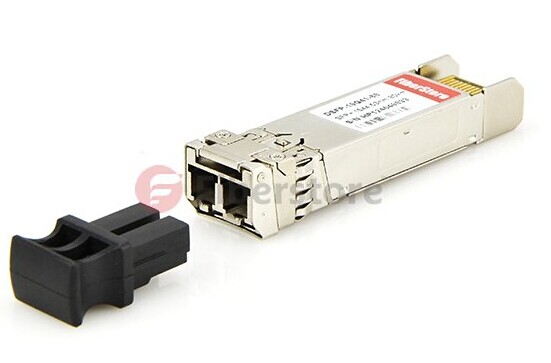The NDC, Network Daughter Card (also known as Select Network Adapters), is an innovation technology developed by Dell. As an advanced technology on server, the NDC provides the customers with a flexibility of choosing what they want ( 4 x 1GbE, 2 x 10GbE or 2 x Converged Network Adapter.) With this small, removable mezzanine card, we are no longer limited to use network interface cards (NICs) on the motherboard. And it has been used in the twelfth-generation Dell PowerEdge server. This article will focus on Broadcom or Intel network adapter for Dell PowerEdge Server.
Network adapter plays an irreplaceable role in a server system, as it can reduce CPU usage on the server, which improves the overall system performance. NDC is a paramount member of Dell PowerEdge Select Network Adapters family. There are two form factors of Select Network Adapters—blade servers and rack servers. (You can see the two servers clearly in the following figure.) The Blade Select Network Adapter provides dual port 10GbE from various suppliers. The Rack Select Network Adapter provides a selection of 1GbE and 10GbE port options, such as 1000Base-T, 10GBASET and 10Gb SFP+.

Figure1: Rack Mount Servers & Blade Servers(Resource: www.DELL.com)
The Blade Select Network Adapter is offered on the PowerEdge M620 blade server.
The Rack Select Network Adapter is offered on the following PowerEdge platforms:
- R620
- R720
- R720xd

Figure2: PowerEdge R720 Rack Server(Resource: www.DELL.com)
- Broadcom 5720 Base-T
- Intel I350 Base-T
- Broadcom 57800 Base-T and SFP+
- Intel x540 Base-T
- Broadcom 57810S KR
- Intel x520 KR
- QLogic QMD8262 KR
Blade servers: There are three form factors of blade servers offered by Dell: Intel x520 Dual Port 10Gb KR NDC, Broadcom 57810S Dual Port 10Gb KR NDC, and QLogic QMD8262-k Dual Port 10Gb KR NDC. Both the Broadcom and Intel blade NDCs will support both 1Gb and 10Gb speeds, while the QLogic blade NDC will run only at 10Gb speeds.
Rack servers: There are mainly two brands of NDC support rack servers—Intel and Broadcom, which would be further explained as follows:
- Intel Ethernet x540 Dual Port 10Gb BT + i350 DP 1Gb BT NDC: A quad-port rack NDC with 2 ports x 1GbE + 2 ports x 10GBASE-T based on the Intel I350 and x540 chipsets.
- Intel Ethernet i350 Quad Port 1GbE NDC: A quad-port rack NDC with 4 ports x 1GbE based on the Intel I350 chipset.
An Intel 2x1Gb + 2x10Gb Base-T rack NDC, as shown in the following figure, offers two types of interconnects to meet various connectivity needs.

Figure3: Rack 2x1Gb+ 2x10Gb BT NDC
- Broadcom 57800S 2x1Gb+2x10Gb SFP+ NDC: A quad-port rack NDC with 2 ports x 1GbE + 2 ports x 10G SFP+ based on the Broadcom 57800S chipset. Just shown as the following figure.
- Broadcom 5720 4x1Gb Base-T NDC: A quad-port rack NDC with 4 ports of 1GbE based on the Broadcom 5720 chipset.

Figure4: Rack 2x1Gb+ 2x10Gb SFP+ NDC
Just take Broadcom 57800S 2x1Gb+2x10Gb SFP+ NDC for example. A Broadcom 2 x 1G + 2 x 10G SFP+ NDC provides two 1000BASE-T ports and two 10G SFP+ ports as shown in Figure 6. We can plug two Dell compatible SFP transceivers into the two 1G ports on the Broadcom NDC respectively to achieve 1G network connection. Likewise, we can also connect Dell compatible SFP+ transceiver such as 10Gb Base SR connector to the 10G port on the Broadcom card for making 10G data transferring. Besides, we can also use Direct Attach Cable (DAC) to achieve 10G network connectivity, such as multimode 10Gb fiber optic cable, Dell 10G SFP+ DAC cable. DAC cables provide a cost-effective solution for very short transmission while 10G optical modules are more suitable for data transferring over long distance.

Figure5: Broadcom 57800S NDC with Dell SFP+ module
As technology advanced and 10Gb Ethernet became more prevalent in the data center, there must be a prosperous market ahead for blade servers and rack servers. SFP+ modules and Direct Copper Attached is the current preference for 10GbE connectivity of rack servers. Boardcom and Intel are both famous vendors for providing NDCs for Dell PowerEdge Server, you can select a proper one for your server according to your port needs.


